Steiner 3551 7x30 Navigator Pro C Binoculars Review
Designed specifically with marine uses in listen and with a whole host of interesting features and components, sure on paper, these Steiner Navigator Pro 7x30 binoculars exercise look like they could pretty much be the ultimate binocular to have on just about any smaller vessel on the h2o, exist that a speed boat, yacht, kayak or canoe and indeed they also seem like they could also more than hold their ain for many dryland uses equally well. So practiced on newspaper, merely just how well do they fare in reality under real-globe testing and use, well in this review nosotros find out: Whilst planning for an upcoming 4-day kayaking and camping trip downwardly the Dordogne river in France, I reached out to a number of binocular manufacturers who make what I thought would brand a good binocular for this particular use and asked if they would exist willing to send me a sample to exam and then review on my return. (See my commodity & video on Choosing The Best Binoculars for Kayaking & Boating). For me, pretty much the very first binocular make to spring to listen, and indeed ended upwards being the showtime I contacted was Steiner. Famous for their toughness and power to survive whatsoever you throw at them, Steiner Optik supply a number of Navies around the globe and are widely accepted as making some of the very best marine binoculars coin can buy. The problem for me and choosing my binoculars for my kayaking trip is the fact that most marine binoculars are designed to be used on larger boats/vessels so size and weight are not a large priority and thus a 7x50 is probably the most common configuration. The skilful news is Steiner produces a few slightly more compact options because of this, I zeroed in on their 7x30 Navigator Pro which I thought could be platonic. Steiner very kindly accepted my asking and a few days afterwards a brand new pair landed on my desk-bound and below is my initial "mini" review along with the thoughts and opinions after testing and using them on my kayaking trip I solely focus on how they performed for me as a binocular for kayaking/boating (notation: the full review, where I will get into far more depth volition follow in due form): Primary Features & Contents: The Ultimate Binocular for Kayaking, Canoeing or for use on any other Modest Boat or Yacht? Shape The combination of the fairly traditional Porro prism shape and the splendid NBR rubber coating that Steiner uses on these simply works. The level of grip yous get is also excellent, which on a modest gunkhole where yous can and often practise get wet is of more importance than ever. Rubber Coating Made from Nitrile butadiene rubber(NBR) it is more than often called Buna-North or Nitrile safe, information technology is special because information technology is able to resist the perishing effect that oil, fuel, and other chemicals have on most other types of rubber. One other very important attribute is that NBR rubber, especially in relation to marine uses where you lot will often go out the binoculars on your boat, is that it also has an excellent level of resistance to sun and heat crumbling then does not harden and perish every bit natural rubber does. Steiner also states that information technology is resistant to the perishing effects of salty water. Main Chassis Material Made for them by Bayer, it is lightweight and very robust. Indeed Steiner advertises it every bit being able to withstand 11G's of impact. So whilst it may not exist as luxurious every bit a magnesium chassis, information technology is more than lightweight and I would suggest easily stiff plenty to handle most mishaps onboard. Atmospheric condition Proofing Indeed they are designed to withsand a water pressure of up to 5 meters. As with many of their other instruments these are as well filled with nitrogen gas under force per unit area and are said by Steiner to prevent fogging up within at temperature range of between -20°C to +60°C. As is well-nigh often the case on this pattern of binocular, all Steiner Navigator Pro binoculars utilize the fold-downwards type of eyecups. Every bit they are less complicated and thus easier and probably likewise cheaper to make than twist-up eye-cups, this type of eyecup is ofttimes found on cheap binoculars, and equally such these depression-quality cups (oft with very little centre-relief) tend to offer a poor user experience. Rather unfairly, they all get tarred with the same castor and I will admit to ofttimes stating in my reviews of binoculars using folding cups that I would have preferred to accept had the twist-upward blazon instead. Just every bit I say, this is usually at the cheaper end of the market, because whilst I would still probably just requite the edge to a high-quality twist-up cup, the ones one these Steiner Navigator Pro binoculars are extremely practiced: Uncomplicated Comfortable Adjustable Steiner'southward Sports-Automobile-Focus System & Diopter Adjustment Oft rather erroneously described equally an "Auto Focus" arrangement which Steiner markets as their "Sports-Auto-Focus" system, I prefer to think of them as an "Always in Focus" binocular as once you take adapted each of the diopters to complement your particular vision the image yous see remains abrupt and in focus from nearly xx meters away correct to infinity and no further adjustments are always required. On the kayak and with a paddle and camera to bargain with, this was certainly an advantage every bit it made it much easier for me to use these Steiner Navigator Pro 7x30 Binoculars with just one hand. The only real downside to this is the fairly long minimum focus distance, but in this situation, I found I was generally looking at the depository financial institution, upwardly at the tops of trees, cliff faces or further upwards the river to navigate the all-time route and thus this was not oft an issue for me. Indeed the but times I wished I could focus at a closer range was to observe things like the dragonflies and dropwings that would often land on our canoe. Likewise notation that if you really need to, you can really reduce the minimum focus altitude on this blazon of system by adjusting each of the diopters and I managed to get these downwards to about 5 meters, withal, this is plain more time consuming than on a binocular with a single focus wheel machinery and the depth of view is also profoundly reduced. Rating for Trunk Construction Quality: eight/10 Weight Nicely padded and with Steiner'due south excellent click-lock attachment system.. I really do like the included neck strap that Steiner provides which is first-class in every way... except for the fact that information technology is too narrow and thus the weight of the instrument is more full-bodied and becomes a little uncomfortable. If I was going to use this binocular more often on the river over long periods of time I would definitely consider getting a wider strap, or fifty-fifty better the Steiner Floating Strap (Particular Number 76800004 - fits Navigator Pro 7x30 binoculars) which would not but be more comfy simply ensure your instrument is more hands retrieved should you drop it overboard. Dimensions But on my first inspection after taking them out of the box, I felt they would exist fine, they fitted quite easily into my daysack forth with all my other gear and so one time out on the river and in the kayak, their slightly larger size was really never an issue for me and I practice retrieve that the extra functioning I got from their larger 30mm lenses was well worth it in this example. Had my trip involved more hiking and backpacking, then aye perhaps I would once again switch back to a full compact. BBR Body Stats Score (compared to 30mm Bins): seven/ten The fact that they employ Porro prisms ways these Steiner Navigator Pro 7x30 binoculars do not require a number of specialist coatings on the prisms and thus the list of optical coatings is shorter than that of about high-end roof prism binoculars, nevertheless I would all the same look them to deliver an equal if not better quality of epitome. Combining a moderate 7x magnification with mid-sized 30mm objective lenses is an interesting setup for a marine binocular: Firstly the moderate 7x power helps make it much easier to continue the image steady and milk shake-free with a lower magnification, which on the unsteady platform of a boat or yacht on the water is of great importance. But this relatively low magnification also produces a few other advantages: Firstly it helps produce a broad field of view and then secondly it also creates a larger go out pupil when compared to binoculars with the same or similar size lenses, but with higher magnifications: 7x30 binoculars produce a healthy iv.3mm exit pupil (30÷7). Because that the objective lenses are fairly small and thus deceit collect as much light every bit larger lenses, these 4.3mm shafts of low-cal exiting the ocular lenses counter information technology to a degree and ensure that your eyes receive enough calorie-free in all but the worst lite conditions when your pupils are dilated and thus larger than the leave pupil. If for example, yous compare these to an standard 10x42 and their 4.2mm exit pupil the departure is very small. Yet if you need a very good depression calorie-free operation, y'all would withal have to sacrifice on size and weight and go for a larger instrument, so something like a 7x50 for example that produce massive exit pupils of more than 7mm. At 21mm in diameter, these have pretty large ocular lenses for a mid-sized binocular in my experience. Large ocular lenses are desired for a number of reasons, which I go through in particular in this article on ocular lens size in binoculars, but one of the most important is that they go far much easier for you to line your eyes upward with them. This combined with their reasonably large get out-pupil makes this instrument very easy to use with less chance of black rings forming on the edges of the view. All this combined with the lack of having to make any sort of adjustments to the focus makes for an incredibly easy instrument to only pick up and use and was something that I really appreciated when out on the water, especially when using the binocular 1-handed.. Simply from this type of body shape, information technology is obvious that these Steiner Navigator Pro 7x30 binoculars and indeed all their marine binoculars have Porro prisms within of them to correct the inverted image created past the lenses. As I mentioned in the torso section above, this design of prism does not make for the most compact shaped binocular, merely information technology does have a number of advantages over the more meaty roof prism design: Probably near importantly is that a Porro prism is far simpler and does not require whatsoever special coatings added to them to correct the light going out of phase as it passes through them, nor do they require whatever highly cogitating mirror coatings to increase the light transmission levels, both of which are needed on a Roof prism to get the best out of them. Whilst the prisms do non need whatever special coatings, Steiner has added a number of coatings to the lenses that assistance improve light transmission and improve image quality: This is certainly what we desire to hear and is one of the key features of what to await for when buying binoculars. You can also read more on Anti-Reflection Lens Coatings here, but essentially these coatings ensure that every bit trivial calorie-free equally possible gets reflected in unwanted directions and away from each of the lenses and and so increases the amount of light gets transmitted right through the instrument and onto your eyes. Steiner Nano-Protection Coatings Steiner markets this as their "Nano-Protection" which repels water and thus maintains a better view in wet conditions, which if you are involved in activities similar ocean kayaking for instance is important. Even if you lot are not, this layer also helps forestall dust and dirt from sticking to the lens surface and prevents watermarks from being left behind, meaning that you demand to clean the lenses less oft, then when you practise, less force is needed which is e'er a good thing. Optical Components Quality Rating: nine/x Field Of View (FOV) Withal, considering the 7x power, I was half expecting them to take a slightly expecting a slightly wider FOV, for example, the Steiner 7x50 C Navigator Pro Binocular has a FOV of 373ft @ 1000 yds and at the very tiptop end of this sector, the Steiner 7x50 Commander C binoculars lead the mode with a massively broad viii.iii° / 438ft @ 1000 yds / 145.4 chiliad @ m m, but simply keep in mind that those more than 4x the cost of these about $1300. Having said all that, for me and how I used them the FOV was plenty wide enough and I never had an issue with being able to chop-chop locate and then follow small fast-moving birds (like a kingfisher) on the bank of the river from the kayak. Close Focus This is one of the "prices to pay" for not having to brand any adjustments to the focus and these Steiner's are no different. So in one case yous accept set up up both diopters to lucifer your vision, the close focus distance on these is nigh 20 meters abroad (depending on your eyesight). If you need to, yous tin can actually reduce the minimum focal altitude a adequately long way by adjusting both of the diopters. Indeed, I managed to get information technology down to a minimum of virtually v meters. However, doing by doing this you also vastly reduces the depth of view. Indeed at this extreme, I would found it to be about 1 meter, notwithstanding, this can notwithstanding be very useful if you sometimes demand to focus on something fairly close by. Either style, this is not really what this blazon of binocular is designed for and so I would still not recommend them to anyone who ofttimes needs to view objects at close range. Eye-Relief: Note: I tested them using my sunglasses and every bit expected was able to achieve the total field of view with them on later completely folding down the eyecups. Optical Stats Rating (compared to 7x Bins): eight/10 Epitome Steadiness: 7x magnification However, and as at-home as much of the water was, I do think it is worth keeping the magnification down to 8x or less every bit even a slight rocking motion on the boat makes it much more hard to proceed the image steady. So for me, the 7x power on these Steiner binoculars was a good pick and I would say that on the water is generally a proficient compromise between image item and steadiness. Image Brightness & Depression Light Operation Besides as this, I know from a tour of their factory, that Steiner uses first-class quality drinking glass (either Hoya from Nippon or Schott in Germany) on all their higher-stop instruments and and so this combined with the knowledge that all the lenses along the whole optical pathway on the Navigator pro have multiple layers of anti-reflection coatings applied to them (fully multi-coated) meant it was no surprise to find that the image brightness, in general, and particularly in the good to average calorie-free conditions that nosotros more often than not experienced on our trip was excellent. In moderate and fifty-fifty fairly low light atmospheric condition I still thought these performed too as I had hoped and it was only in very depression light at sunset that the operation noticeably drops off if you compare them to a larger instrument similar an 8x42 or 7x50 for examples. Color Reproduction & Contrast Color Fringing Caused by chromatic aberrations, color fringing is mostly more difficult to control with high magnifications, so even though the Steiner Navigator Pro 7x30 Binoculars does not have ED glass (which is designed to reduce chromatic aberrations), the level of observable colour fringing, fifty-fifty under extremes like viewing a black telephone wire against a bright bluish, sunlit sky merely showed very little amounts which is impressive and they compare very favorably even against the very best in this expanse. Image Flatness & Softening The image remains sharp and in focus from the center of the view correct to the edges and they bear witness near zero image softening at the border of the view. In my experience, this extremely minimal corporeality is certainly less than the bulk of instruments that I exam. Also worth noting is that I never noticed whatever sort of distortions that can brand the epitome look curved or wavy. Image Quality Rating (for Mid-Size Binoculars): nine/x This includes a soft comport bag, padded neck strap, objective lens covers, rain-guard, cleaning cloth, and an instruction booklet: The carry case is well made and well padded, but other than that information technology is pretty basic and lacks any extra pockets or a chugalug loop. The instance does come with its own carry strap, but this is unpadded. For a get-go, you can instantly tell that it is well made using good quality materials and the stitching looks reasonably good and there is no doubt in my mind that information technology will be long-lasting. I like the attention to fine details, for example, Steiner has added not one, only two metal ring connectors on each side of the strap (4 in total), these free up the strap to movement into a more natural position as you bring the binocular up to your eyes. I'll concord that this is a very minor point, but the many, many, many straps that I have tested that don't have these can often feel rather strong and get in the way much more oftentimes and so information technology is something that I do certainly appreciate. Also as this, the two lower rings are actually separate-rigs which makes it very simple for you to attach these binoculars to just about any binocular harness should yous wish. I was really going to endeavor this, but because I was likewise testing two other instruments and had my camera effectually my neck, I decided against a bino harness, but I call up using ane on a canoe could be a very practiced idea. Another highlight of the strap is that Steiner uses their ClicLoc Strap Attachment System on it which is splendid: Instead of the usual slider system where yous fold and thread the strap back on itself, that is a bit of a hurting to ready up (particularly for me every bit I have washed it literally thousands of times!), Steiner has a quick-release prune on the end of the strap that simply clicks into a receptor located ether side of the body of the binocular. Not only does this make for a much cleaner, integrated wait, only information technology is far, far quicker to add together an remove the strap should you wish. The padded department is for me the office that lets this strap down a little. Information technology is well padded, but just to narrow (25mm). So whilst it is fine for short periods, I institute that it would dig into my neck and thus go uncomfortable after about an hour or and so. Steiner Floating Neck Embossed with the Steiner logo on the ends, I like the fact that the cups are obviously designed specifically for this model and not a generic part fabricated in their millions and used by many manufacturers. Made from what looks like a combination of prophylactic and plastic, the cups are designed to fit into the ends of the barrels whereas about cups fit over the ends and often just look similar an afterthought and not a function of the musical instrument. The fit is also tight enough to ensure they don't come away too easily, nevertheless are reasonably easy to accept off and put dorsum. I likewise like that they are tethered to the central hinge and not over each of the barrels. This allows them to hang downwardly in the middle of binocular and completely out of the way when non in use, but always there for you to hands supersede when needed. Also important to note here is that the prophylactic used for the tethering looks and feels fairly robust and thus should final as this is a function that often fails on binoculars that I test. Whilst I ALWAYS ensure that they are replaced in one case I get home in social club to preclude dust from settling into the ocular lenses. When out in the field (on dry state), I usually don't employ them much and almost never take the fourth dimension to attach the pelting-baby-sit to the neck strap as it just gets in the way. Withal, on h2o (and especially where sea spray is involved), they ensure the oculars remain dry and in optimal condition and so for my trip I took the fourth dimension to thread the pelting-guard onto my neck strap and and so used it much more than usual. In one case again, this process was fabricated much easier because of Steiner's quick-release neck strap. The fit on the one that comes with the Steiner Navigator Pro 7x30 Binoculars is perfect and they hands flop over the acme of the eyecups making them a sure-fire to return, but at the aforementioned time the rubber of the eyecup and that on the rain-guard, rub together just enough to ensure that information technology does not come away too easily. Cleaning Material Warranty Extras Rating: 8/10 And then did the Steiner Navigator Pro 7x30 binoculars live up to my high expectations? Sure they may not exist able to match a 7x50 in terms of optical functioning (in low light), and so if you are in a larger vessel where size and weight are not every bit important, and so a 7x30 may not exist the right configuration and you should rather opt for something like the Steiner Navigator Pro 7x50 or Fujinon Polaris 7x50 FMTRC-SX Binoculars that I accept also reviewed. Only on the flip side, these are far smaller and more than lightweight than a full-sized marine binocular, and whilst not quite as small, they hands outperform a total compact, thus for me, they perfectly fill that centre ground of providing a good performance to size/weight ratio. Buid Quality Fantabulous Eyes & Image Ease of Use The 7x magnification helps produce a steady shake-complimentary image and allows for the actually wide field of view, which forth with not having to make any focal adjustments meant that I was easily able to find and follow even the fastest moving birds on the shoreline. Attention to Particular Whilst certainly not essential, Steiner'southward Hydrophobic "Nano-Protection" is a very squeamish feature to accept on the water and I love the manner the water acts similar it is nearly allergic to the drinking glass and just runs off it. Besides equally enabling better views in spray/rain, cleaning the drinking glass is easier considering of these coatings. Well padded and well made using excellent quality materials... the neck strap is first-class in only near every fashion, except for the fact that it is too narrow. Over shorter periods, this is fine for a relatively lightweight instrument, but after a full day in my canoe, I did get-go to feel it effectually my neck and wished for a wider strap. Information technology is a compassion Steiner doesn't supply these Navigator Pro's with their excellent looking floating strap equally standard. Minimum Focus Distance Marine Binoculars Obviously designed with watery environments in mind I feel these Steiner Navigator Pro 7x30 binoculars can also be used in a wide diversity of other applications that do non necessarily include water. Birdwatching Binoculars The broad field of view you become from these along with an excellent quality image in my mind makes these an first-class pick as a mid-sized birding binocular, be that from a boat or on state. Wild animals & Full general Wild fauna Sports Binoculars Survivalists & Binoculars for Preppers! Non Good For: Steiner Navigator Pro 7x30 Binoculars Review
Because I took my time and did a lot of research before selecting these Steiner Marine binoculars as one of the instruments that I would take to use equally and examination on my iv-twenty-four hour period Kayaking / Camping ground trip down the Dordogne river in South West France, I was pretty confident that they would excel in this environment and for my intended use and I had very high expectations for them. 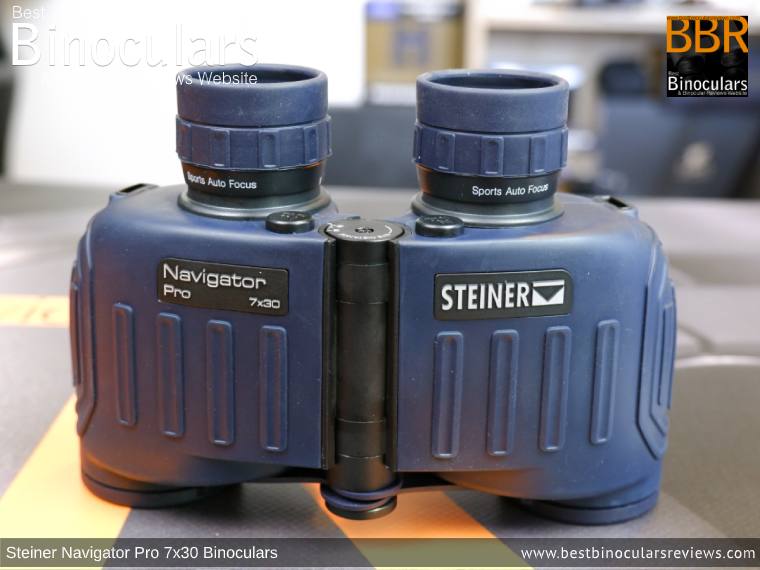
The Torso
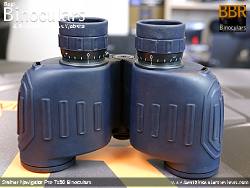 In terms of comfort when holding them in my hands, I really tin can retrieve of many (if any) instruments that I would call more comfy to use than these 30mm Steiner Navigator Pro binoculars.
In terms of comfort when holding them in my hands, I really tin can retrieve of many (if any) instruments that I would call more comfy to use than these 30mm Steiner Navigator Pro binoculars.
Like many, if not most of their other summit-end instruments, Steiner incorporates their "NBR Long Life rubber" armor on all their marine binoculars. 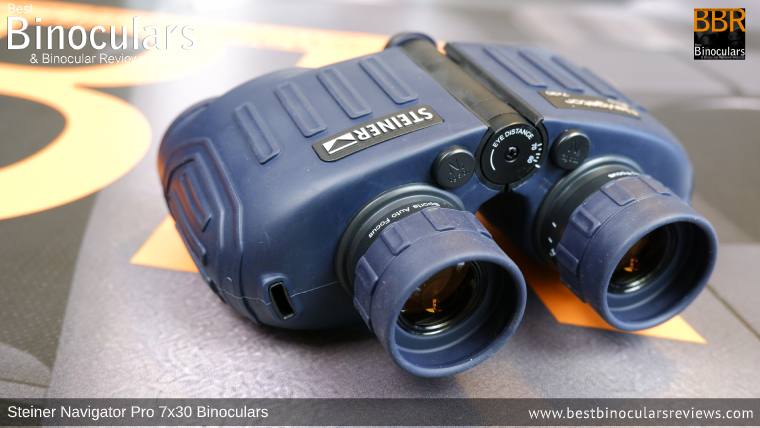
As with the exterior armor, Steiner has apparently put a lot of thought into the materials used for the chassis: Instead of magnesium that many higher-end instruments will present utilize, Steiner actually uses a polycarbonate Makrolon housing.
Every bit with whatever marine binocular worth its salt, the Steiner Navigator Pro 7x30 binoculars accept fully waterproof and fogproof O-band seals.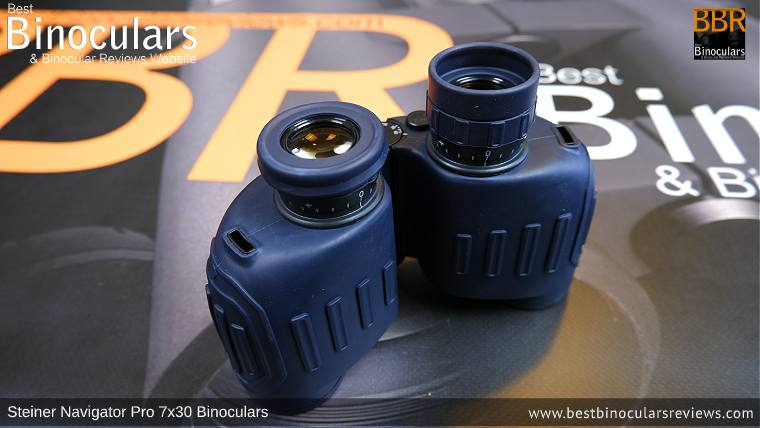
Eyecups
The simple design ways there is less to go wrong, and less to interruption should y'all drop your instrument.
I establish the cups themselves to be very comfy fifty-fifty when pushed firmly against my face and this is certainly ane expanse where they have the advantage over the twist-up type on about binoculars.
If you need to reduce the eye-relief for case because you wearable glasses, then yous tin can simply fold down the cup. This works, but it has to be said does not give you as many options as the better twist-upwardly ones which will often have ane or more than intermediate click-stops.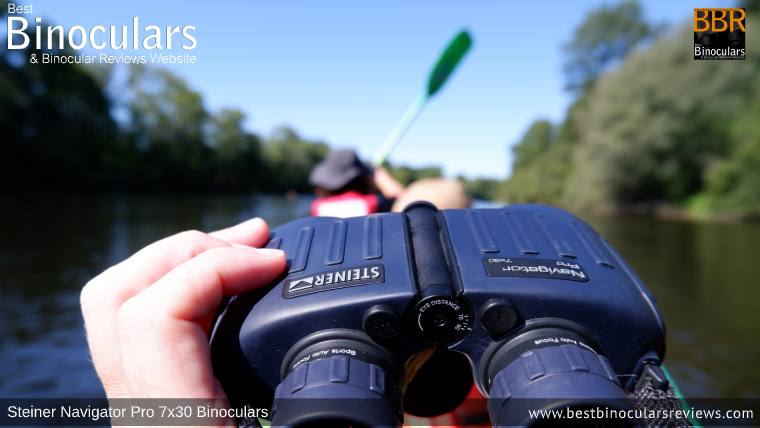
Focusing
These Steiner Navigator Pro 7x30 Binoculars don't have a focus cycle, rather they comprise a diopter adjuster on each of the eyepieces. 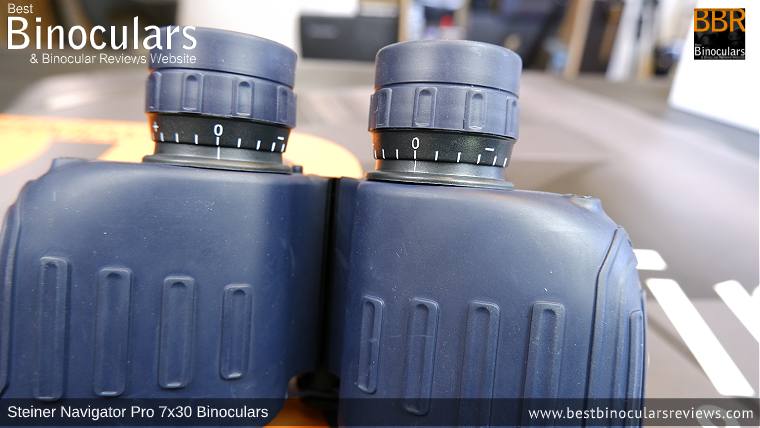
To a point and whilst on a boat, the weight of your binoculars is not actually an issue equally dissimilar walking, the vessel is doing most of the carrying for you lot. However, I would say that whilst I would not describe them in any way equally being heavy, afterward a total day of kayaking, I did start to feel the weight of these Steiner Navigator Pro binoculars around my cervix towards the end.
In the past, I have e'er used a total meaty binocular (usually around 26mm lenses) when either canoeing or kayaking, and thus before receiving this mid-sized Steiner with its wide Porro prism shape, I must confess to being a petty worried that they may not exist quite equally compact as I would have preferred.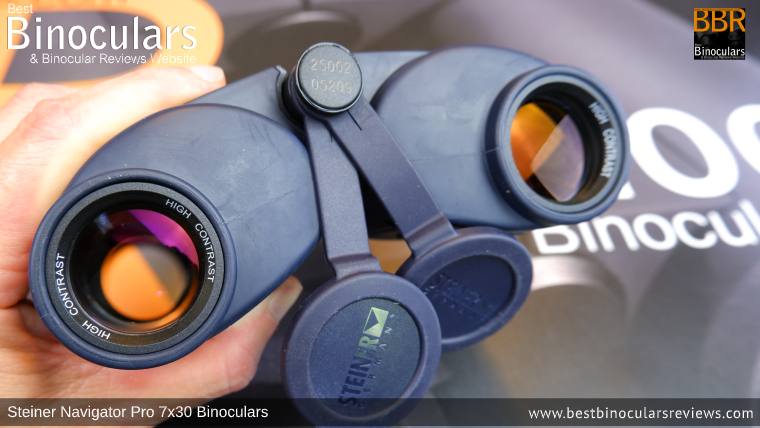
The Optics
7x30mm Configuration
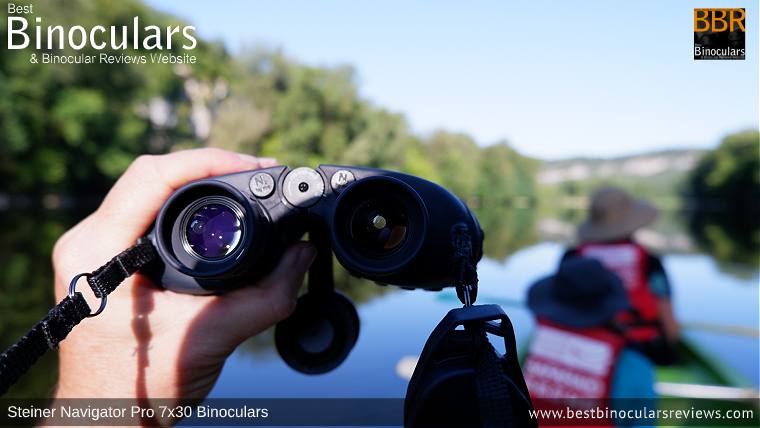
Ocular Lenses
Prisms
Optical Coatings
Anti-Reflection Coatings
Steiner has added multiple coatings of a special anti-reflection material to ALL of the optical surfaces throughout the system and non just the showtime and last lenses, which is sometimes the case on lesser instruments.
One optical blanket that is important to mention hither for their intended marine uses is that they have a hydrophobic/aquaphobic cloth on the outer lens surfaces. Optical Stats
At 123m wide when measures at a distance of 1,000 meters abroad (369ft at 1,000 yards), the field of view on the Steiner Navigator Pro 7x30 Binoculars is certainly broad if you are used to looking through an 8x mid-sized binocular.
Fixed focus / ever in focus binoculars like these are designed to have a very long depth of view (large hyperfocal distance) and thus it is normal for them to have a relatively long minimum close focus distance when compared to a standard focusing binocular.
At 17.4 mm, I would not describe the Steiner Navigator Pro 7x30 binoculars every bit having a very long centre-relief, merely for a mid-sized musical instrument, it is pretty skilful and should be enough for nearly eyeglass wearers. 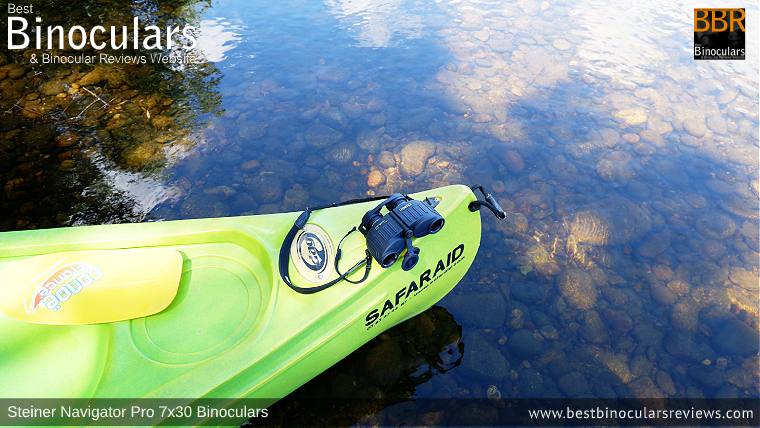
The Image Quality
The section of the Dordogne river that we paddled down was pretty slow-moving and tranquil virtually of the time and even the "rapid sections" were for us pretty piece of cake to navigate (except for one!). This was by choice equally we were going equally a family and thus as well as my photographic camera, we had my ix-year-old daughter as well equally our domestic dog in the canoe.
The 7x30 configuration gives you lot exit pupils of effectually 4.3mm (xxx÷7), which is pretty much the same every bit the 4.2mm that you get with a 10x42 binocular and thus in terms of image brightness I was expecting these to provide me with a similar type of experience pregnant that, they should perform well enough in all but pretty poor calorie-free atmospheric condition and this indeed turned out to be the case:
I idea both were very practiced and these binoculars deliver a vibrant, but natural-looking image with a proficient variation betwixt the lightest and darkest areas of the view
 Due to the moderate 7x magnification and excellent quality optics, I was hoping and one-half expecting that this musical instrument would only prove a very minimal amount of color fringing and thankfully I was not to be disappointed:
Due to the moderate 7x magnification and excellent quality optics, I was hoping and one-half expecting that this musical instrument would only prove a very minimal amount of color fringing and thankfully I was not to be disappointed:
In terms of the paradigm quality, this is another area where this Steiner binocular really impressed me. 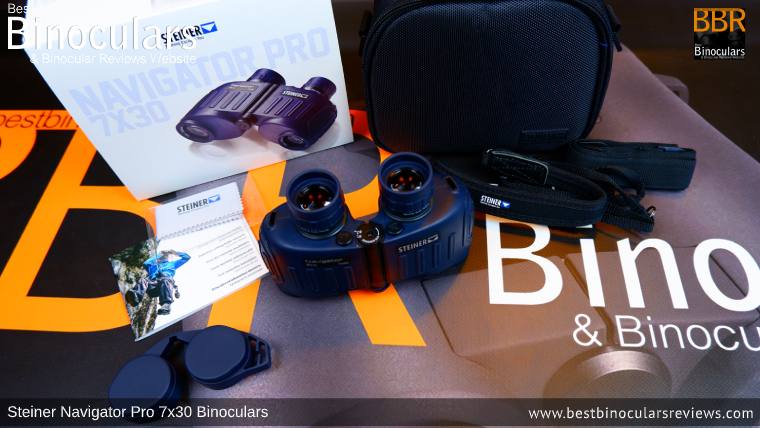
Included Accessories:
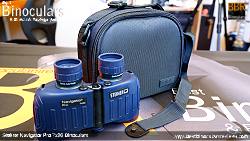 Included in the box with these Steiner Navigator Pro 7x30 binoculars are a number of accessories.
Included in the box with these Steiner Navigator Pro 7x30 binoculars are a number of accessories. Acquit Case
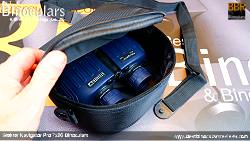 The fit of the binoculars when inside is a piddling likewise spacious for my liking pregnant that they tin flop nearly somewhat, although this is reduced somewhat when yous include the neckstrap in with them.
The fit of the binoculars when inside is a piddling likewise spacious for my liking pregnant that they tin flop nearly somewhat, although this is reduced somewhat when yous include the neckstrap in with them.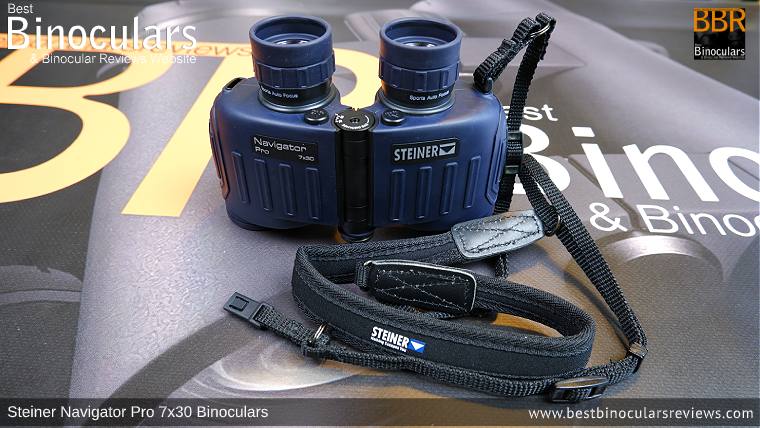
Neck Strap
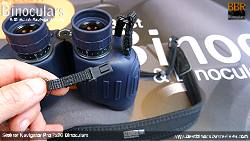 As I accept already mentioned in the weight section of this review, for the nearly office, I feel that the included neck strap is excellent and I would rate information technology as one of the all-time...except for 1 area:
As I accept already mentioned in the weight section of this review, for the nearly office, I feel that the included neck strap is excellent and I would rate information technology as one of the all-time...except for 1 area: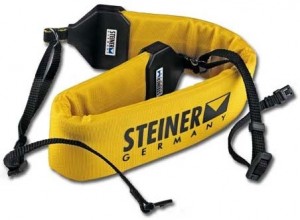 For a lightweight compact, this would be the just about best strap you lot could ever hope to go, merely for these, I would have much preferred wider padded section that would distribute the weight more evenly.
For a lightweight compact, this would be the just about best strap you lot could ever hope to go, merely for these, I would have much preferred wider padded section that would distribute the weight more evenly.
Strap Steiner does make some fantabulous floating neck staps designed for marine uses and one that is designed to work with these Navigator Pro 7x30 binoculars (Item Number 76800004). It looks to me to be wider, and I will ask for confirmation. So if you are planning on using these bins often on a boat and for long periods, I would consider getting information technology. Priced at effectually $49 / 49 Euros. Click Here for Current Prices & Where to PurchaseLens Covers
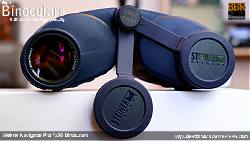 The objective lens covers are excellent, but when you consider them for apply on the water whilst a small boat like a kayak, I would upgrade this to them being truly superb where it is certainly the case of a number of small things all calculation upwards:
The objective lens covers are excellent, but when you consider them for apply on the water whilst a small boat like a kayak, I would upgrade this to them being truly superb where it is certainly the case of a number of small things all calculation upwards: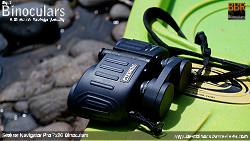 Rain-Baby-sit
Rain-Baby-sit
Another seemingly insignificant part, which becomes much more than important on a boat like a canoe is the ocular lens encompass (rain-guard):
Every bit with all the Steiner binoculars that I accept reviewed, made from amicro-fiber material, the included cleaning cloth is of good quality. Even so, I would nevertheless highly recommend purchasing an inexpensive lens cleaning kit for the proper cleaning of the lenses. 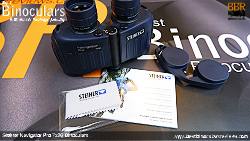 Instructions
Instructions
As is the norm, the included instruction booklet looks substantial, but includes a number of languages and then but includes some basic information like naming the parts, how to adhere the strap, adjusting the IPD, focussing likewise as cleaning and maintaining the instrument.
In the Us, these Steiner binoculars come with a Lifetime Warranty. In Europe, they are covered by a xxx year guarantee.Review Conclusions:
Yes, most certainly: If you lot are in the market for a high operation, but reasonably compact binocular to have on merely about any canoe, kayak, gunkhole, yacht, or indeed just about any marine vessel then I take absolutely no hesitation in highly recommending these Steiner Navigator Pro 7x30 binoculars and I will most certainly be using them once more of future trips and probably use them as my criterion for this type of use. Strengths & Highlights:
An extremely well-made musical instrument using high-quality components very comfortable in the hands, with high levels of grip.
Loftier-quality glass and coatings deliver a bright, vibrant view with extremely low levels of color fringing and almost no softening around the edges of the view.
The "always in focus" system and not having to adjust the focus is an excellent characteristic in this context of using it on a canoe/kayak and certainly made the binocular much easier to employ in one hand and ensured I didn't miss out on seeing that kingfisher darting about.
The objective lens covers are excellent as they fit very well into the ends of the barrels (as opposed to over them) and I also really similar how they are tethered to the cardinal swivel and thus hang downward in the eye of binocular and completely out of the way when not in employ, but always at that place for you to easily supercede when needed. Weaknesses:
I guess you would include the relatively long minimum focus distance as a weakness of this type of musical instrument that does not have a single focusing machinery and then if y'all need to observe objects from close range, this will not be the binocular for you. Ideal Uses:
This is a no brainer: with their moderate 7x magnification, tough waterproof housing and aquaphobic coatings these are designed specifically for this purpose. The Steiner Navigator Pro 7x30 binocular an excellent choice for use on most pocket-sized vessels, be that speed boating, sailing, yachting or indeed kayaking and boating.More than Just a Marine Binocular:
From my canoe, I spent a lot of time birding, be that waders similar wagtails on the bank, birds on the water like ducks, swifts in the many cliffs faces we passed and and so smaller fast-moving birds like kingfishers likewise every bit larger raptors like the buzzards nosotros get in this part of France.
Likewise and then long equally yous don't need a very short minimum focus distance or indeed need a lot of detail at a long-range, I experience these Steiner Navigator Pro'due south tin more than than concord their own equally an all-circular wildlife and full general apply instrument.
Here once more, the wide field of view ensures that you are able to take in more of the onfield action at once without having to pan about and I feel their size is withal compact enough for y'all to easily pack them away into your daysack.
Here again their toughness, immovability will all exist of neat use.
Because of their relatively long minimum focal distance, I wouldn't recommend them for uses like insect or butterfly observation, taking to museums or anywhere where yous need to focus on objects at close range.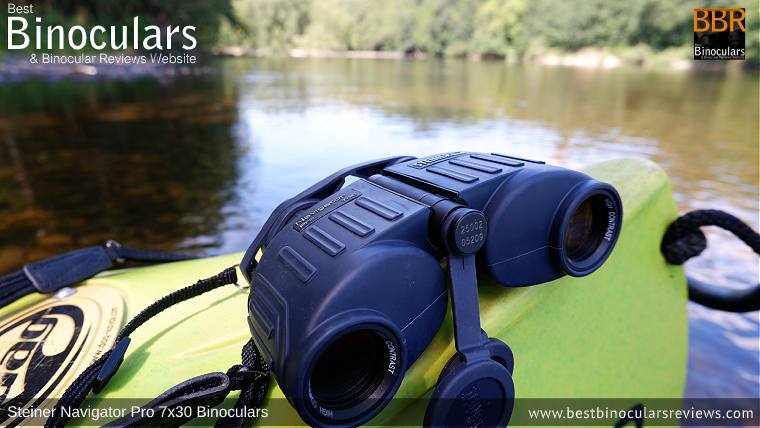
Reviewed by Jason Whitehead for All-time Binocular Reviews
Best Binocular Reviews Ratings:
| Trunk Construction Quality: | viii/ten | 82% Outstanding |
| Torso Stats: | vii/10 | |
| Optical Components Quality: | 9/10 | |
| Optical Stats: | 8/x | |
| Image Quality | 9/10 | |
| Extras & Attending to Detail: | 8/10 |
Compare Prices & Where to Buy the Steiner Binoculars
Main Specifications & Features:
- Size: Mid Size Binoculars
- [explain prism types]Prism Blazon: Porro Prism Binoculars
- Magnification: 7x
- [explain objective lens]Objective Lens Diameter: 30mm
- [explain waterproofing]Waterproof: Yes
- [about fogproofing]Fogproof: Aye
- [explain leave pupil]Leave Student: four.three
- [explain twilight factor]Twilight Factor: 14.49
- [explain eye relief]Eye Relief: 17.4mm
- [explain IPD]IPD Max: seven.4cm
- IPD Min: v.6cm
- Weight: xix.9ozs (564g)
- Length: four.3in (10.9cm)
- Height: 2.3in (5.8cm)
- Width: 6.6in (16.8cm)
- Eyecup Diameter: 35mm
- Ocular Lens Diameter: 21mm
- [explicate field of view]Field of View: 123m at 1,000 meters
- [explicate field of view]Field of View: 369ft at one,000 yards
- Chassis Material: Polycarbonate
- Prototype Stabilization: No
- [about Lens Coatings]Lens Coatings: Fully Multi-Coated
- [about ED Drinking glass]Extra Low Dispersion Glass: No
- Auto Focus: Yeah
Steiner 7x30 Navigator Pro Binoculars Video Review
2021-04-17 https://img.youtube.com/vi/Jrg3D2mj380/mqdefault.jpg
Source: https://www.bestbinocularsreviews.com/Steiner-Navigator-Pro-7x30-Binoculars-Review-268.htm
0 Response to "Steiner 3551 7x30 Navigator Pro C Binoculars Review"
Post a Comment